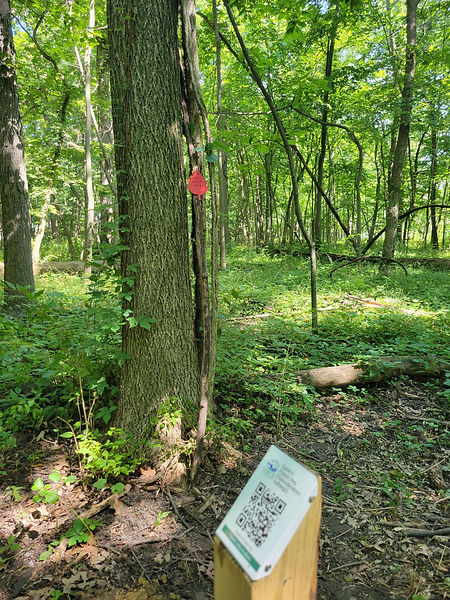Eastern Poison Ivy (Toxicodendron rydbergii)

The poison ivy vine is growing along the white ash tree
Research conducted by: Isla Carter, Morgan Proctor, and Ali Harp, Grosse Ile High School Students
General Characteristics:
-
Grow throughout much of North America, including Canadian Maritime provinces, all U.S. states east of the Rocky mountains, and mountainous areas of Mexico.
-
They typically have hair and ropelike vines. They have 3 shiny leaves that are budding from 1 small stem.
Commercial Value:
Used as dye/ink
Wildlife Value:
-
White tailed deer, raccoons, and black bears eat the leaves, fruit, and stems. It provides cover for small animals and acts as a path to climb up and down trees.
-
Wasps, ants, and other insects get pollen from them
Interesting Tidbits:
The rash doesn't show up right away, not everyone is allergic to the plant, the rash isn't contagious
Additional Information
General Characteristics:
Eastern Poison Ivy, scientifically known as Toxicodendron rydbergii, is a native vine commonly found in North America. This plant is notorious for its ability to cause allergic reactions upon contact due to the presence of urushiol oil in its leaves, stems, and roots. Eastern Poison Ivy can grow as a ground cover or climb structures and trees, reaching heights of up to 4 feet as a shrub or trailing vine. It is a perennial plant, meaning it can live for more than two years, and typically exhibits a reddish tint in the spring, green in the summer, and yellow or red in the fall.
Range:
This plant is widespread across the eastern and central United States and Canada. It thrives in diverse habitats, including forests, fields, wetlands, and disturbed areas like roadsides and urban environments. Eastern Poison Ivy is highly adaptable, preferring well-drained soils and partial to full sun exposure but can also tolerate a variety of other soil and light conditions.
How to Identify:
Identifying Eastern Poison Ivy involves recognizing its distinctive features:
-
Leaves: Typically, three leaflets per leaf stem, with the middle leaflet having a longer stalk. The leaf edges can be smooth, toothed, or lobed.
-
Stems: Woody, with aerial roots if the plant is climbing.
-
Flowers: Small, yellow-green clusters that appear in late spring to early summer.
-
Berries: White to grayish-white drupes that mature in late summer to fall.
Commercial Value:
Eastern Poison Ivy has limited commercial value due to its toxic nature. However, it is sometimes used in traditional medicine, albeit with caution, for its purported anti-inflammatory properties. Its primary value lies in its ecological roles rather than direct human uses.
Wildlife Value:
Despite being a nuisance to humans, Eastern Poison Ivy is valuable to wildlife. Many bird species, including quail, turkeys, and various songbirds, consume its berries. Additionally, deer and other mammals may browse the leaves and stems, particularly during winter when other food sources are scarce.
Symbiotic Relationships:
Eastern Poison Ivy has several ecological relationships that benefit its survival. For instance, birds that eat its berries help in seed dispersal, ensuring the propagation of the plant. The plant can also form associations with mycorrhizal fungi in the soil, which aid in nutrient absorption.
Interesting Tidbits:
-
The phrase “Leaves of three, let it be” is a common mnemonic to help people avoid contact with Eastern Poison Ivy.
-
Urushiol, the compound causing skin irritation, is not only found in Eastern Poison Ivy but also in poison oak, poison sumac, and even in the shell of the cashew nut.
-
Eastern Poison Ivy can regenerate from root fragments, making it resilient and often difficult to eradicate completely.
-
Despite its bad reputation, it plays a crucial role in its ecosystem, supporting various wildlife and contributing to the biodiversity of the regions it inhabits.


Hairy ropelike vines and 3 shiny leaves that are budding from 1 small stem.